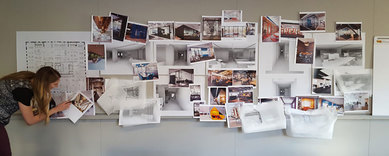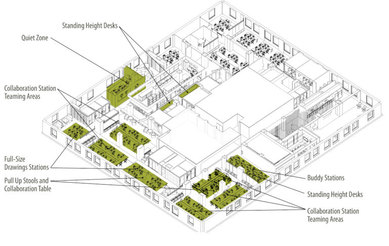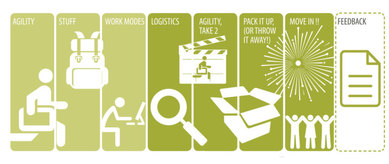Redefining the Way We Work: Design Evolution Through Research and Prototyping
At SmithGroup, we believe that great design emerges through the iteration, research, and prototyping of design solutions. And our success is derived from our understanding that no two clients are the same—including when we are our own client.
As we began to design a new workspace in the Chicago office for the first time in nine years, we first looked introspectively. Over three full days of workshops, that gathered input from all employees, we examined our culture and asked: What do we want to celebrate? In what areas do we need to grow? How will we adapt in the future? The results identified our organization as multidisciplinary, nimble, innovative, and collaborative, fueled by diverse perspectives.
We then sought to determine if our existing Chicago office aligned with the type of design firm we saw ourselves as. By diagramming our previous workstation set-up, we realized we were missing the nimbleness that our teams needed to operate at their highest potential. While our desks were set up in pods to allow us to sit by our team members, these pods and our relationships to them were not flexible. If a team grew larger than six members, teammates would be displaced into a secondary pod. If a team member was on multiple teams, they had to choose which team they needed to sit closer to, indefinitely. This inflexibility was something we knew we needed to tackle in the new space.
To design a workstation that maximized the benefit of team-based activity, we surveyed the staff and asked employees to identify a work typology that best reflected the way they most often work. The results revealed that no single typology was preferred or worked for every discipline or every phase of our design process. This was the first major piece of data that supported reevaluating our design process to adopt an agile, free address environment—giving employees the ability to choose and change their workstation throughout the day to best suit one’s current activity, preference, or desired proximity to other team members.
While our path toward agile seating seemed evident, we knew there was still more insight to gather. So we focused our research on the work typologies of employees and identified three main agile workstyles:
- The Independent—an individual who works autonomously and on many projects and can choose where to sit based on preference or activity
- The Multi-teamer—an individual who engages with multiple teams and benefits from agility as it allows them to sit with each team as often as required
- The Resident Teamer—an individual who works with one team on long-term projects. This person’s activities are relatively stationary, but he or she often becomes the central point around which other team members gather.
To fine tune the design to uniquely fit our culture, these workstyles were helpful in determining the mix of workstations required in our new space. Resident Teamers were provided larger desks with room to display project materials, pull-up stools accommodate Multi-teamers who need to drop in for a quick conversation and quiet corners away from collaboration zones are ideal for Independents and focus work.
While working with a number of industry partners, we prototyped and tested the variety of workstation scenarios, studying appropriate dimensions for collaboration and exploring options to ensure a visual differentiation between individual and teaming spaces. Team members also piloted tools and technologies that would aid the transition to a free address environment seamless. Each scenario was tested in full-scale, and assessed by the entire office through surveys to ensure that the prototyped workstations and tools would support and enhance the way we work in the new office.
But how would we determine exactly how many stations we would need? What if everyone wanted the same typology in the same area? We again turned to research. By examining our previous space, we were able to determine that approximately 30 percent of our workstations went unused at any given time—either due to paid time off, on-site client meetings, or employees working in other offices. Ultimately, this metric led the design team to build a 1:1 (workstation: employee) ratio to provide choice while allowing more area for a unique mix of ancillary spaces.
We knew that there would be concerns around free address seating and wanted to understand the challenges we would face with the transition. By surveying employees’ comfort with agility, we were able to ascertain all practical design issues that needed physical resolution, as well as perceived operational issues. These became the framework of our change management plan. Through this plan, we were able to create solutions, address concerns, and prepare staff for a smooth transition.
A constant feedback loop with the entire office and the subsequent evolution of design has followed us even after we’ve moved into our new space. We are still collecting quantitative and qualitative data from employees to ensure we continue to create a workplace that is uniquely and successfully ours.



